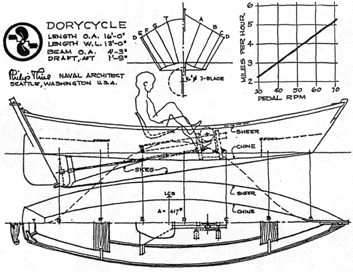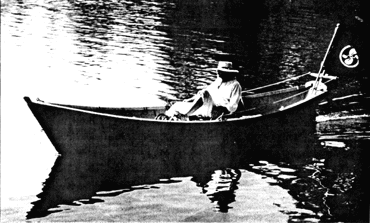| * DESIGN FILE * | DORYCYCLE: * Description * Dorycycle Layout * ***T-SHIRTS*** |

|


|
To live in the Pacific Northwest and to not have a boat is
against a law of nature, if not immoral.
But what does one do if one does not care to cope with the whims of the
wind, nor suffer the noise and stink of a motor? Use one's human power, obviously - the
original and most personal means of movement on the face of the waters. But paddling is tiring, and rowing is backwards, so what is left?Pedal power, of course! Why not sit comfortably, face forward, use one's more powerful leg muscles, and have one's hands free for more interesting things? And just as the invention of the wheel made things go more smoothly on land, at the cost of some slight complication, so also does the marine propeller provide an efficient conversion of torque into thrust in the water. So much for propulsion. What about flotation? There are many options here. since speed is not the name of MY game (once I am out on the water, I am already "there") a New England background suggested the advantages of the capable Banks dory: easy to build, and well-proven in deep-sea work-boat service. Thus the DORYCYCLE: Sixteen feet overall (13 feet on the water-line), built of fir plywood and oak, it weighs about 300 pounds. The challenge was to see what could be done with the sustained power available to an "ordinary untrained bicyclist", estimated to be 0.20 hp at 50 pedal rpm. Using the simplest possible components (off-the-shelf V-belt and pulleys) and a home-made propeller fabricated of epoxied laminations of marine plywood, the DORYCYCLE will make 3.8 miles per hour all day long. A cutaway skeg protects the propeller, provides both directional stability and lateral plane, and permits good maneuverability. The DORYCYCLE handles beautifully, is very responsive, and is a perfect delight to use. |
 |
© 2001-2013 by Philip Thiel Seattle WA USA |